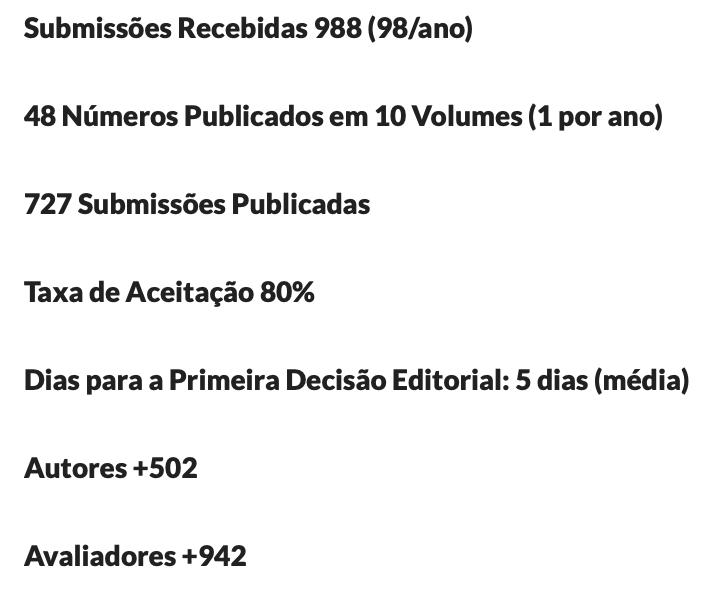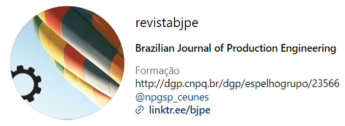Processos oxidativos avançados no tratamento de efluentes: tendências recentes e análise bibliométrica
DOI:
https://doi.org/10.47456/bjpe.v10i4.46204Palavras-chave:
Tratamento de efluentes, Processo foto-fenton, FotocatáliseResumo
O descarte inadequado de efluentes industriais é um dos principais responsáveis pela liberação de substâncias tóxicas, quimicamente complexas e não biodegradáveis em corpos hídricos. Diante disso, os Processos Oxidativos Avançados (POAs), tecnologias responsáveis por oxidar poluentes através da geração de radicais oxigenados, têm ganhado destaque no tratamento de águas residuais por serem métodos considerados promissores, eficazes e inovadores. Neste trabalho, foi realizada uma análise bibliométrica na base de dados Web of Science com o objetivo de verificar a relevância e os avanços do tema em questão. Inicialmente, a estratégia de busca foi utilizar a palavra-chave “advanced oxidation processes” e, em seguida, adicionou-se a palavra “water treatment”. A China foi o país com o maior número de publicações antes e após a inserção do segundo termo, e a área de pesquisa Engenharia configurou-se como a área de maior relevância. Após isso, foram acrescentados separadamente na busca diversos POAs juntamente com as duas palavras citadas anteriormente, com o intuito de determinar as técnicas mais relevantes, e as 3 técnicas que apresentaram os resultados mais expressivos foram analisadas, sendo elas Foto-Fenton, H2O2/UV e fotocatálise heterogênea. Por fim, uma matriz SWOT foi elaborada contendo pontos positivos e negativos presentes em um grupo de artigos selecionados.
Downloads
Referências
Adeoye, J. B., Tan, Y. H., Lau, S. Y., Tan, Y. Y., Chiong, T., Mubarak, N. M., & Khalid, M. (2024). Advanced oxidation and biological integrated processes for pharmaceutical wastewater treatment: A review. Journal of Environmental Management, 353, 120170. https://doi.org/10.1016/j.jenvman.2024.120170 DOI: https://doi.org/10.1016/j.jenvman.2024.120170
Andrade, G. R. S., Nascimento, C. C., Silva Júnior, E. C., Mendes, D. T. S. L. & Gimenez, I. F. (2017). ZnO/Au nanocatalysts for enhanced decolorization of an azo dye under solar, UV-A and dark conditions. Journal of Alloys and Compounds, 710, 557-566. https://doi.org/10.1016/j.jallcom.2017.03.295 DOI: https://doi.org/10.1016/j.jallcom.2017.03.295
Babu Ponnusami, A., Sinha, S., Ashokan, H., V Paul, M., Hariharan, S. P., Arun, J., Gopinath, K. P., Hoang Le, Q. & Pugazhendhi, A. (2023). Advanced oxidation process (AOP) combined biological process for wastewater treatment: A review on advancements, feasibility and practicability of combined techniques. Environmental Research, 237, 116944. https://doi.org/10.1016/j.envres.2023.116944 DOI: https://doi.org/10.1016/j.envres.2023.116944
Bar-Niv, N., Azaizeh, H., Kuc, M. E., Azerrad, S., Haj-Zaroubi, M., Menashe, O., & Kurzbaum, E. (2022). Advanced oxidation process UV-H2O2 combined with biological treatment for the removal and detoxification of phenol. Journal of Water Process Engineering, 48, 102923. https://doi.org/10.1016/j.jwpe.2022.102923 DOI: https://doi.org/10.1016/j.jwpe.2022.102923
Bokare, A. D. & Choi, W. (2014). Review of iron-free Fenton-like systems for activating H2O2 in advanced oxidation processes. Journal of Hazardous Materials, 275, 121-135. https://doi.org/10.1016/j.jhazmat.2014.04.054 DOI: https://doi.org/10.1016/j.jhazmat.2014.04.054
Brillas, E. & Martínez-Huitle, C. A. (2015). Decontamination of wastewaters containing synthetic organic dyes by electrochemical methods. An updated review. Applied Catalysis B: Environmental, 166-167, 603-643. https://doi.org/10.1016/j.apcatb.2014.11.016 DOI: https://doi.org/10.1016/j.apcatb.2014.11.016
Cambié, D., Bottecchia, C., Straathof, N. J. W., Hessel, V., & Noël, T. (2016). Applications of Continuous-Flow Photochemistry in Organic Synthesis, Material Science, and Water Treatment. Chemical Reviews, 116(17), 10276-10341. https://doi.org/10.1021/acs.chemrev.5b00707 DOI: https://doi.org/10.1021/acs.chemrev.5b00707
CDP. (2022). Global Water Report 2022. Carbon Disclosure Project. Recuperado de https://www.cdp.net/en/research/global-reports/global-water-report-2022
Esfandian, H., Mirzaei, S., Chari, A. S., Ghadi, R. A., & Moqadam, I. H. (2024). Photocatalytic degradation of chlorpyrifos pesticide in aqueous solution using Cu-doped TiO2/GO photocatalysis vicinity of UV and visible light. Materials Science and Engineering: B, 305, 117385. https://doi.org/10.1016/j.mseb.2024.117385 DOI: https://doi.org/10.1016/j.mseb.2024.117385
Ghanbari, F. & Moradi, M. (2017). Application of peroxymonosulfate and its activation methods for degradation of environmental organic pollutants: Review. Chemical Engineering Journal, 310, 41-62. https://doi.org/10.1016/j.cej.2016.10.064 DOI: https://doi.org/10.1016/j.cej.2016.10.064
Guz, R., Tiburtius, E. R. L., & Pessôa, C. A. (2023). Association of adsorption and heterogeneous photocatalysis in the degradation of Tartrazine yellow dye with CuNb2O6 synthesized and immobilized on chitosan membranes. Inorganic Chemistry Communications, 152, 110645. https://doi.org/10.1016/j.inoche.2023.110645 DOI: https://doi.org/10.1016/j.inoche.2023.110645
Hama Aziz, K. H. & Mustafa, F. S. (2024). Advanced oxidation processes for the decontamination of heavy metal complexes in aquatic systems: A review. Case Studies in Chemical and Environmental Engineering, 9, 100567. https://doi.org/10.1016/j.cscee.2023.100567 DOI: https://doi.org/10.1016/j.cscee.2023.100567
Harris, R. & Rother, M. (2002). Creating Continuous Flow: An Action Guide for Managers, Engineers & Production Associates. Lean Enterprise Institute.
Hu, Z., Guan, D., Sun, Z., Zhang, Z., Shan, Y., Wu, Y., Gong, C., & Ren, X. (2023). Osmotic cleaning of typical inorganic and organic foulants on reverse osmosis membrane for textile printing and dyeing wastewater treatment. Chemosphere, 336, 139162. https://doi.org/10.1016/j.chemosphere.2023.139162 DOI: https://doi.org/10.1016/j.chemosphere.2023.139162
Humayun, S., Hayyan, M., & Alias, Y. (2025). A review on reactive oxygen species-induced mechanism pathways of pharmaceutical waste degradation: Acetaminophen as a drug waste model. Journal of Environmental Sciences, 147, 688-713. https://doi.org/10.1016/j.jes.2023.11.021 DOI: https://doi.org/10.1016/j.jes.2023.11.021
Jiang, H., Chen, H., Duan, Z., Huang, Z., & Wei, K. (2023). Research progress and trends of biochar in the field of wastewater treatment by electrochemical advanced oxidation processes (EAOPs): A bibliometric analysis. Journal of Hazardous Materials Advances, 10, 100305. https://doi.org/10.1016/j.hazadv.2023.100305 DOI: https://doi.org/10.1016/j.hazadv.2023.100305
Krishnan, R. Y., Manikandan, S., Subbaiya, R., Biruntha, M., Govarthanan, M., & Karmegam, N. (2021). Removal of emerging micropollutants originating from pharmaceuticals and personal care products (PPCPs) in water and wastewater by advanced oxidation processes: A review. Environmental Technology & Innovation, 23, 101757. https://doi.org/10.1016/j.eti.2021.101757 DOI: https://doi.org/10.1016/j.eti.2021.101757
Lee, W., Marcotullio, S., Yeom, H., Son, H., Kim, T.-H., & Lee, Y. (2022). Reaction kinetics and degradation efficiency of halogenated methylparabens during ozonation and UV/H2O2 treatment of drinking water and wastewater effluent. Journal of Hazardous Materials, 427, 127878. https://doi.org/10.1016/j.jhazmat.2021.127878 DOI: https://doi.org/10.1016/j.jhazmat.2021.127878
Mohammed, S., Prathish, K. P., Jeeva, A., & Shukla, S. (2024). Integrated Fenton-like and ozonation based advanced oxidation processes for treatment of real-time textile effluent containing azo reactive dyes. Chemosphere, 349, 140766. https://doi.org/10.1016/j.chemosphere.2023.140766 DOI: https://doi.org/10.1016/j.chemosphere.2023.140766
Moreira, F. C., Boaventura, R. A. R., Brillas, E., & Vilar, V. J. P. (2017). Electrochemical advanced oxidation processes: A review on their application to synthetic and real wastewaters. Applied Catalysis B: Environmental, 202, 217-261. https://doi.org/10.1016/j.apcatb.2016.08.037 DOI: https://doi.org/10.1016/j.apcatb.2016.08.037
Olatunde, O. C., Kuvarega, A. T., & Onwudiwe, D. C. (2020). Photo enhanced degradation of contaminants of emerging concern in waste water. Emerging Contaminants, 6, 283-302. https://doi.org/10.1016/j.emcon.2020.07.006 DOI: https://doi.org/10.1016/j.emcon.2020.07.006
Oliveira, R. A., Castro, M. A. M., Porto, D. L., Aragão, C. F. S., Souza, R. P., Silva, U. C., Bomio, M. R. D., & Motta, F. V. (2024). Immobilization of Bi2MoO6/ZnO heterojunctions on glass substrate: Design of drug and dye mixture degradation by solar-driven photocatalysis. Journal of Photochemistry and Photobiology A: Chemistry, 452, 115619. https://doi.org/10.1016/j.jphotochem.2024.115619 DOI: https://doi.org/10.1016/j.jphotochem.2024.115619
Oturan, M. A. & Aaron, J.-J. (2014). Advanced Oxidation Processes in Water/Wastewater Treatment: Principles and Applications. A Review. Critical Reviews in Environmental Science and Technology, 44(23), 2577-2641. https://doi.org/10.1080/10643389.2013.829765 DOI: https://doi.org/10.1080/10643389.2013.829765
Padovan, R. N., de Carvalho, L. S., de Souza Bergo, P. L., Xavier, C., Leitão, A., dos Santos Neto, Á. J., Lanças, F. M., & Azevedo, E. B. (2021). Degradation of hormones in tap water by heterogeneous solar TiO2-photocatalysis: Optimization, degradation products identification, and estrogenic activity removal. Journal of Environmental Chemical Engineering, 9(6), 106442. https://doi.org/10.1016/j.jece.2021.106442 DOI: https://doi.org/10.1016/j.jece.2021.106442
Patel, M., Kumar, R., Kishor, K., Mlsna, T., Pittman, C. U. Jr., & Mohan, D. (2019). Pharmaceuticals of Emerging Concern in Aquatic Systems: Chemistry, Occurrence, Effects, and Removal Methods. Chemical Reviews, 119(6), 3510-3673. https://doi.org/10.1021/acs.chemrev.8b00299 DOI: https://doi.org/10.1021/acs.chemrev.8b00299
Posser, Y. M. (2016). Degradação da cafeína através dos processos oxidativos avançados fenton e foto- fenton.
Preethi, Shanmugavel, S. P., Kumar, G., N, Y. K., M, G., & J, R. B. (2024). Recent progress in mineralization of emerging contaminants by advanced oxidation process: A review. Environmental Pollution, 341, 122842. https://doi.org/10.1016/j.envpol.2023.122842 DOI: https://doi.org/10.1016/j.envpol.2023.122842
Rigotto, L., Aquino, S. F., Rigotto, J., Santos, G., Silva, L. M. L., & Santiago, A. F. (2023). Dynamics of dissolved organic matter (DOM) in waste stabilization ponds: Insights into co-treatment of sanitary sewage and landfill leachate. Journal of Water Process Engineering, 55, 104236. https://doi.org/10.1016/j.jwpe.2023.104236 DOI: https://doi.org/10.1016/j.jwpe.2023.104236
Sandoval, M. A., Vidal, J., Calzadilla, W., & Salazar, R. (2022). Solar (electrochemical) advanced oxidation processes as efficient treatments for degradation of pesticides. Current Opinion in Electrochemistry, 36, 101125. https://doi.org/10.1016/j.coelec.2022.101125 DOI: https://doi.org/10.1016/j.coelec.2022.101125
Saravanan, A., Deivayanai, V. C., Kumar, P. S., Rangasamy, G., Hemavathy, R. V., Harshana, T., Gayathri, N., & Alagumalai, K. (2022). A detailed review on advanced oxidation process in treatment of wastewater: Mechanism, challenges and future outlook. Chemosphere, 308, 136524. https://doi.org/10.1016/j.chemosphere.2022.136524 DOI: https://doi.org/10.1016/j.chemosphere.2022.136524
Sirés, I., Brillas, E., Oturan, M. A., Rodrigo, M. A., & Panizza, M. (2014). Electrochemical advanced oxidation processes: Today and tomorrow. A review. Environmental Science and Pollution Research, 21(14), 8336-8367. https://doi.org/10.1007/s11356-014-2783-1 DOI: https://doi.org/10.1007/s11356-014-2783-1
Soares, P. B., Carneiro, T. C. J., Calmon, J. L., & Castro, L. O. da C. de O. (2016). Análise bibliométrica da produção científica brasileira sobre Tecnologia de Construção e Edificações na base de dados Web of Science. Ambiente Construído, 16, 175–185. https://doi.org/10.1590/s1678-86212016000100067 DOI: https://doi.org/10.1590/s1678-86212016000100067
UNESCO. (2023). The United Nations World Water Development Report 2023: Partnerships and cooperation for water—UNESCO Digital Library. https://unesdoc.unesco.org/ark:/48223/pf0000384655
Van Eck, N. J. & Waltman, L. (2023). Manual for VOSviewer version 1 .6.20. Recuperado de https://www.vosviewer.com/documentation/Manual_VOSviewer_1.6.20.pdf
Vinayagam, V., Palani, K. N., Ganesh, S., Rajesh, S., Akula, V. V., Avoodaiappan, R., Kushwaha, O. S., & Pugazhendhi, A. (2024). Recent developments on advanced oxidation processes for degradation of pollutants from wastewater with focus on antibiotics and organic dyes. Environmental Research, 240, 117500. https://doi.org/10.1016/j.envres.2023.117500 DOI: https://doi.org/10.1016/j.envres.2023.117500
Wang, C., Shi, P., Wang, Z., Guo, R., You, J., & Zhang, H. (2023). Efficient wastewater disinfection through FeOOH-mediated photo-Fenton reaction: A review. Journal of Environmental Chemical Engineering, 11(6), 111269. https://doi.org/10.1016/j.jece.2023.111269 DOI: https://doi.org/10.1016/j.jece.2023.111269
Wang, C.-C., Li, J.-R., Lv, X.-L., Zhang, Y.-Q., & Guo, G. (2014). Photocatalytic organic pollutants degradation in metal–organic frameworks. Energy & Environmental Science, 7(9), 2831-2867. https://doi.org/10.1039/C4EE01299B DOI: https://doi.org/10.1039/C4EE01299B
Yang, Y., Ok, Y. S., Kim, K.-H., Kwon, E. E., & Tsang, Y. F. (2017). Occurrences and removal of pharmaceuticals and personal care products (PPCPs) in drinking water and water/sewage treatment plants: A review. Science of The Total Environment, 596-597, 303-320. https://doi.org/10.1016/j.scitotenv.2017.04.102 DOI: https://doi.org/10.1016/j.scitotenv.2017.04.102

Downloads
Publicado
Como Citar
Edição
Seção
Licença
Copyright (c) 2024 Victor Hugo de Oliveira Santiago, Katherine Jisselle Flores Vasquez, Marcio Cypriano de Lima, Carla da Silva Meireles, George Ricardo Santana Andrade (Autor)

Este trabalho está licenciado sob uma licença Creative Commons Attribution 4.0 International License.

Atribuição 4.0 internacional CC BY 4.0 Deed
Esta licença permite que outros remixem, adaptem e desenvolvam seu trabalho não comercialmente, contanto que eles creditem a você e licenciem suas novas criações sob os mesmos termos.
















































































